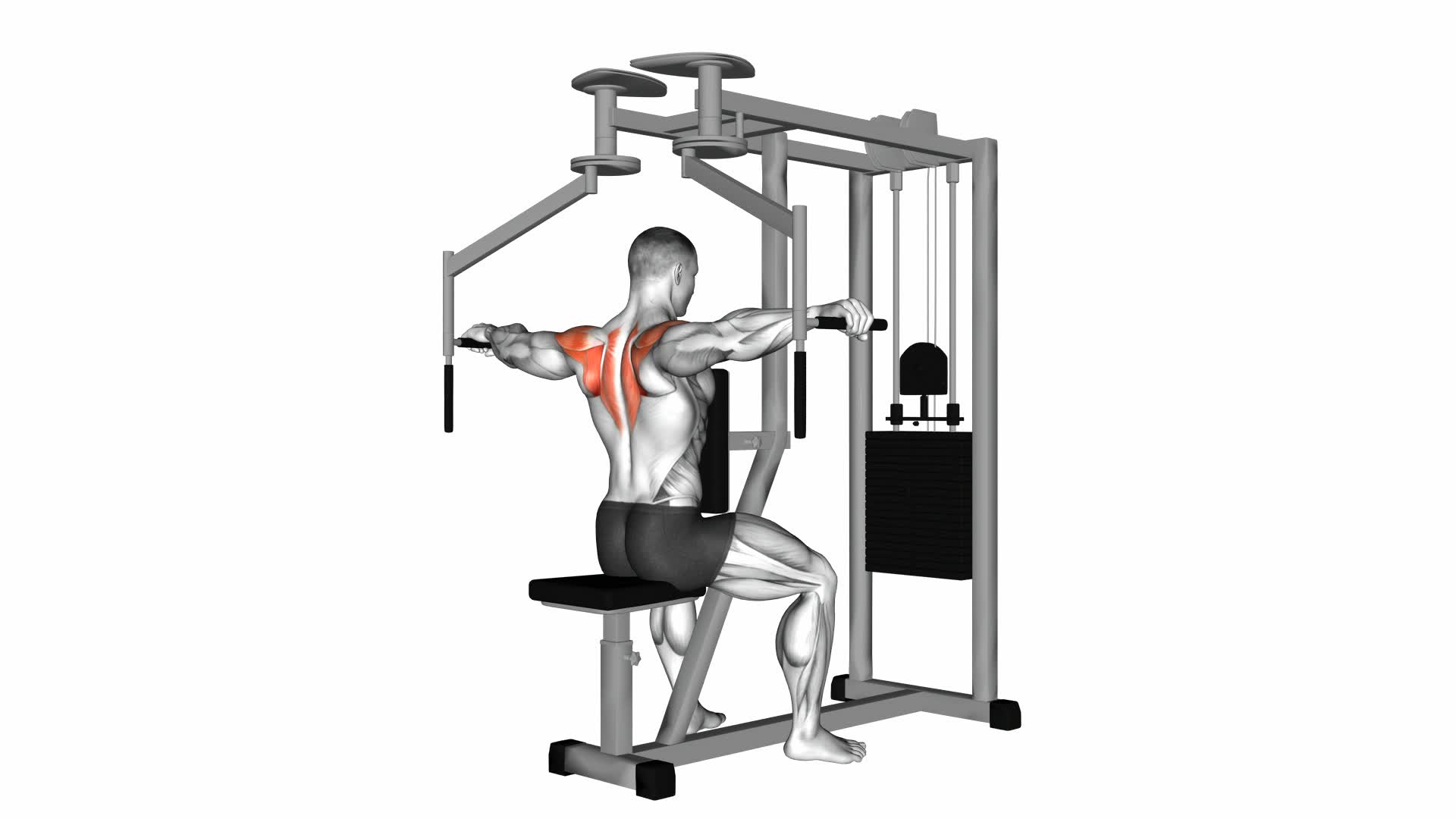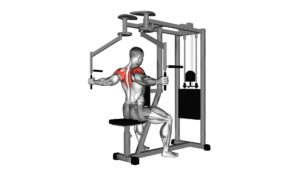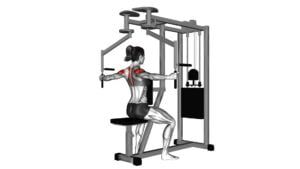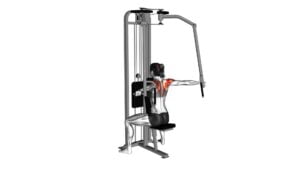Lever Seated Reverse Fly – Video Exercise Guide & Tips

Are you looking for a new exercise to target your upper back muscles? Look no further than the lever seated reverse fly!
Watch This Exercise Video
In this video exercise guide, you'll learn the proper form and technique for this effective exercise. We'll also provide tips for maximizing your results and preventing injury.
Whether you're a beginner or advanced fitness enthusiast, there are variations and modifications to suit your fitness level.
Let's get started and strengthen those back muscles!
Key Takeaways
- The lever seated reverse fly exercise improves posture and strengthens the upper back muscles.
- It can alleviate back pain and promote upright and aligned posture.
- The exercise enhances upper body strength and should be performed with controlled and stable movement.
- It is recommended to start with a light weight, gradually increase weight, and adjust weight and repetitions based on targeted muscle groups.
Benefits of the Lever Seated Reverse Fly
To maximize the effectiveness of your workout, it's important to understand the benefits that the Lever Seated Reverse Fly can bring to your fitness routine. This exercise is particularly beneficial for improving posture and strengthening the upper back muscles.
One of the key benefits of the Lever Seated Reverse Fly is its ability to improve posture. By targeting the muscles in the upper back, this exercise helps to counteract the effects of sitting and slouching for extended periods of time. Strengthening these muscles can help to alleviate back pain and promote a more upright and aligned posture.
In addition to improving posture, the Lever Seated Reverse Fly also targets and strengthens the upper back muscles. These muscles, such as the rhomboids and rear deltoids, play a crucial role in maintaining proper shoulder alignment and stability. Strengthening these muscles can enhance your overall upper body strength and help prevent injuries.
Proper Form and Technique for the Exercise
To ensure that you perform the Lever Seated Reverse Fly with proper form and technique, focus on engaging your upper back muscles and maintaining a controlled and stable movement throughout the exercise. This exercise primarily targets your posterior deltoids, rhomboids, and upper trapezius.
One common mistake people make when performing the Lever Seated Reverse Fly is using too much weight. It's important to start with a light weight and gradually increase it as you become more comfortable and confident with the movement. Using too much weight can compromise your form and lead to injury.
Another mistake to avoid is hunching your back or rounding your shoulders. To maintain proper form, keep your back straight and your shoulders down and back. This will ensure that you're effectively targeting the intended muscle groups and minimizing strain on other areas.
Additionally, it's important to control the movement throughout the exercise. Avoid using momentum or swinging your arms. Instead, focus on a slow and controlled motion, squeezing your shoulder blades together at the top of the movement.
Recommended Weight and Repetitions
Start with a light weight and gradually increase it as you become more comfortable and confident with the Lever Seated Reverse Fly, while maintaining proper form and technique. It's important to choose an appropriate intensity that challenges your muscles but still allows you to complete the desired number of repetitions with proper form. This will vary depending on your fitness level and strength.
Here are some recommendations for weight and repetitions to help you get started with the Lever Seated Reverse Fly:
- Begin with a weight that allows you to perform 10-12 reps with proper form. This weight should feel challenging but manageable.
- As you progress and your muscles become stronger, gradually increase the weight. Aim to increase it by 5-10% at a time.
- Once you can comfortably perform 12 reps with the increased weight, consider adding an additional set to further challenge your muscles.
Remember, the Lever Seated Reverse Fly primarily targets the posterior deltoids, rhomboids, and middle trapezius muscles. Adjust the weight and repetitions accordingly to effectively work these muscle groups and achieve your fitness goals.
Always listen to your body and make adjustments as needed to prevent injury and ensure continued progress.
Tips for Maximizing Results and Preventing Injury
To maximize your results and prevent injury while performing the Lever Seated Reverse Fly, it's important to focus on proper form and technique. One of the most common mistakes people make is using too much weight. It's crucial to start with a weight that allows you to maintain control throughout the entire movement. Using excessive weight can lead to poor form, which increases the risk of injury.
Another important tip is to warm up properly before starting the exercise. Performing warm-up exercises such as shoulder rotations and arm circles can help increase blood flow to the muscles and prepare them for the Lever Seated Reverse Fly. This will help improve your range of motion and reduce the likelihood of injury.
When performing the exercise, it's essential to maintain a neutral spine and engage your core muscles. Avoid rounding your back or leaning forward, as this can strain your lower back and compromise your form. Focus on squeezing your shoulder blades together and keeping your shoulders down and away from your ears.
Remember to breathe throughout the exercise and avoid holding your breath. Exhale as you bring the handles together and inhale as you return to the starting position.
Variations and Modifications for Different Fitness Levels
Choose the appropriate weight and resistance level that suits your fitness level for the Lever Seated Reverse Fly. It's important to start with a weight that challenges you but still allows you to maintain proper form throughout the exercise.
Here are some exercise modifications for beginners and advanced variations for experienced individuals:
- Exercise modifications for beginners:
- Start with lighter dumbbells or resistance bands to build strength and technique.
- Perform the exercise seated on a stability ball instead of a bench to engage your core muscles.
- Decrease the range of motion by not fully extending your arms during the exercise.
- Advanced variations for experienced individuals:
- Increase the weight and resistance to further challenge your muscles.
- Perform the exercise on an unstable surface, such as a BOSU ball, to engage more stabilizer muscles.
- Incorporate a pause at the top of the movement or add a rotational twist for added difficulty.
Frequently Asked Questions
Is the Lever Seated Reverse Fly Suitable for People With Shoulder Injuries?
The lever seated reverse fly can be modified for people with shoulder injuries. It's important to consult with a fitness professional or physical therapist to determine the appropriate modifications for your specific condition.
This exercise can help improve overall shoulder strength by targeting the rear deltoids and upper back muscles. However, it's crucial to start with light weights and perform the exercise with proper form to avoid further injury.
Can the Lever Seated Reverse Fly Help Improve Posture?
The lever seated reverse fly is an effective exercise that can help improve your posture. By targeting the muscles in your upper back and shoulders, this exercise helps strengthen the muscles responsible for maintaining proper posture.
Additionally, the lever seated reverse fly offers variations, such as using different grip positions or adjusting the resistance, allowing you to customize the exercise to your specific needs and goals.
Incorporating this exercise into your workout routine can provide numerous benefits for your posture and overall strength.
How Long Does It Take to See Noticeable Results From Doing the Lever Seated Reverse Fly?
When it comes to seeing noticeable results from shoulder exercises like the lever seated reverse fly, it can vary from person to person.
However, with consistent strength training, you can start to see improvements in your posture and upper body strength within a few weeks.
Remember to focus on proper form and gradually increase the resistance to challenge your muscles.
Stay committed and you'll see the results you're looking for.
Is It Necessary to Use a Specific Type of Lever Machine for This Exercise?
When doing the lever seated reverse fly exercise, it isn't necessary to use a specific type of lever machine. However, using a lever machine can offer benefits such as providing a stable and controlled motion.
If you don't have access to a lever machine, there are alternative exercises you can do to target the same muscles. These include bent over dumbbell reverse flys or cable reverse flys.
Can the Lever Seated Reverse Fly Be Performed Without a Spotter?
Yes, you can perform the lever seated reverse fly without a spotter. It's a safe exercise for shoulder health and can be done independently.
However, it's always recommended to start with a lighter weight and gradually increase as you become more comfortable.
If you don't have access to a lever machine, there are alternative exercises like dumbbell rear delt flies or cable reverse flies that can target the same muscles.
Conclusion
In conclusion, the lever seated reverse fly is a highly effective exercise for strengthening the muscles in your upper back and shoulders.
By maintaining proper form and technique, using the recommended weight and repetitions, and following the tips for maximizing results and preventing injury, you can achieve great outcomes with this exercise.
Additionally, variations and modifications are available to suit different fitness levels.
Incorporate the lever seated reverse fly into your workout routine to improve your upper body strength and posture.

Author
Years ago, the spark of my life’s passion ignited in my mind the moment I stepped into the local gym for the first time. The inaugural bead of perspiration, the initial endeavor, the very first surge of endorphins, and a sense of pride that washed over me post-workout marked the beginning of my deep-seated interest in strength sports, fitness, and sports nutrition. This very curiosity blossomed rapidly into a profound fascination, propelling me to earn a Master’s degree in Physical Education from the Academy of Physical Education in Krakow, followed by a Sports Manager diploma from the Jagiellonian University. My journey of growth led me to gain more specialized qualifications, such as being a certified personal trainer with a focus on sports dietetics, a lifeguard, and an instructor for wellness and corrective gymnastics. Theoretical knowledge paired seamlessly with practical experience, reinforcing my belief that the transformation of individuals under my guidance was also a reflection of my personal growth. This belief holds true even today. Each day, I strive to push the boundaries and explore new realms. These realms gently elevate me to greater heights. The unique combination of passion for my field and the continuous quest for growth fuels my drive to break new ground.







